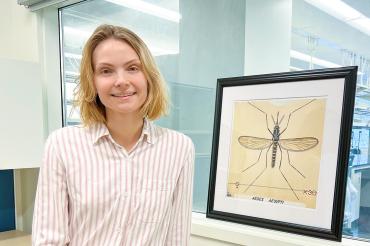New research tool tackles deadly mosquito-borne diseases

Published: February 7, 2023
For most people living in Canada, mosquitoes are nothing more than a summertime nuisance, intruding on nights at the cottage and evenings around the campfire. But for millions of people around the world, particularly in the Global South, they are a serious and potentially fatal threat.
According to a 2017 report from the World Health Organization, mosquito-transmitted diseases such as malaria, dengue and Chikungunya affect an estimated 347.8 million people annually and are responsible for nearly 450,000 deaths each year, making the insects one of the most dangerous animals in the world.
Yet, despite a devastating impact that’s predicted to get worse as climate change drives global temperatures higher, research on the mosquito has lagged behind that of other model organisms such as the fruit fly – in part due to the lack of appropriate tools and resources.
Kathryn Rozen-Gagnon is trying to change that.
She recently joined the department of molecular genetics in the Temerty Faculty of Medicine as an assistant professor. Her lab will study the relationship between mosquito-borne viruses and their mosquito and human hosts. Specifically, she is focusing on viruses such as Zika, dengue and Chikungunya, which have RNA as their genetic material.
“It fascinates me that you have a virus with this very small piece of single-stranded RNA that encodes about 10 genes and yet, with this minimal system, it can navigate very, very different host species,” says Rozen-Gagnon, who is also a member of the Emerging and Pandemic Infections Consortium (EPIC), one of several Institutional Strategic Initiatives at the university.
Rozen-Gagnon’s approach integrates diverse fields like computational biology, insect immunology, RNA biology and virology to dissect how these viruses succeed by interacting with their hosts’ RNA and immune systems. As a post-doctoral fellow and research associate in Nobel Laureate Charles Rice’s lab at the Rockefeller University, she developed cutting-edge methods to better understand how the mosquito immune system responds to viral infection.
One of the tools she created is a universal software package called CLIPflexR that can help researchers uncover a protein’s RNA targets. It improves upon existing software by providing a more reproducible and streamlined approach for data analysis. More importantly, CLIPflexR has the flexibility to work with genome datasets from any organism, including ones like the mosquito where genomes are not as complete or well characterized as the genomes of more commonly studied species.
Using this new software package, Rozen-Gagnon mapped out the RNA targets for a family of RNA-binding proteins called Argonaute proteins, which play a crucial role in mosquitoes’ antiviral defence. Mosquitoes rely on a system called RNA interference to protect themselves from viral infection. A specific Argonaute protein facilitates this by targeting and destroying viral RNA, which reduces virus replication.
“It’s important that the virus can maintain a high level in the mosquito without damaging the mosquito too much because it needs that mosquito to go on to bite people,” says Rozen-Gagnon. “Some scientists have argued that this RNA-based immune response enables viral persistence by keeping the virus at a level where it’s not going to have negative effects on the mosquito, but there is still enough virus to transmit to humans,”
By providing snapshots of which RNAs are targeted by Argonaute proteins, her work is providing new insights into how the mosquito’s immune system maintains this delicate balance.
To further expand the toolbox for mosquito research, Rozen-Gagnon developed the first-of-its-kind CRISPR gene editing system optimized for mosquito cells. The new tool allows scientists to conduct large genetic studies using mosquito cells grown in a lab to understand the function of different genes. In a proof-of-principle study published in Scientific Reports, she and her colleagues showed that the mosquito-optimized CRISPR system was efficient and versatile. Further, because the system uses DNA components known as plasmids, which are cheap to buy and easy to make and modify, it is more cost-effective than versions that rely on expensive purified proteins.
“This is a really great tool that will allow us to ask, what mosquito genes are important for virus replication?” says Rozen-Gagnon. “We haven’t been able to do that using updated gene editing technologies like CRISPR in an unbiased way.
“It also democratizes who can do these kinds of studies. Providing cheap methods like this one allows labs from many different parts of the world to contribute to the field in a meaningful way, which I think is very important.”
Both tools will play a central role in her lab’s work as she continues to delve into the inner workings of mosquito immunity and the interplay between viral infection and a particular type of RNA called microRNA in human and mosquito cells.
Rozen-Gagnon’s research will be further enabled by access to an insectary in the revitalized Toronto High Containment Facility, which recently received a $35 million federal investment to support its modernization. The specially designed space will allow her to infect mosquitoes with viruses like dengue and Chikungunya in a safe and secure way and conduct complementary studies in lab-grown mosquito cells and live insects.



